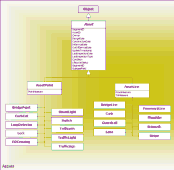Development of draft book/whitepaper and UML code
| 2000 May | Administrative launch | |
| 2000 Jun 24/25 | Stakeholder consultation at ESRI User Conference, San Diego CA | |
| 2000 Jul/Oct | Refinement of stakeholder
inputs and supporting research
Development of draft book/whitepaper and UML code |
|
| 2000 Nov 3/4 | European stakeholder consultation, Turin, Italy | |
| 2000 Nov/Dec | Refinement and development | |
| 2000 Dec 7/8 | Presentation of draft and consultation, Redlands CA | |
| 2001 Jan/Apr | Final refinement and development | |
| 2001 May 11 | Release of UML and white paper | |
| TBA | Release of UNETRANS book |
 |
| [Click to enlarge] Figure 1: Extract from UNETRANS data model |
| UCSB | Mike Goodchild good [at] ncgia.ucsb.edu |
| ESRI | Ernie Ott eott [at] esri.com |